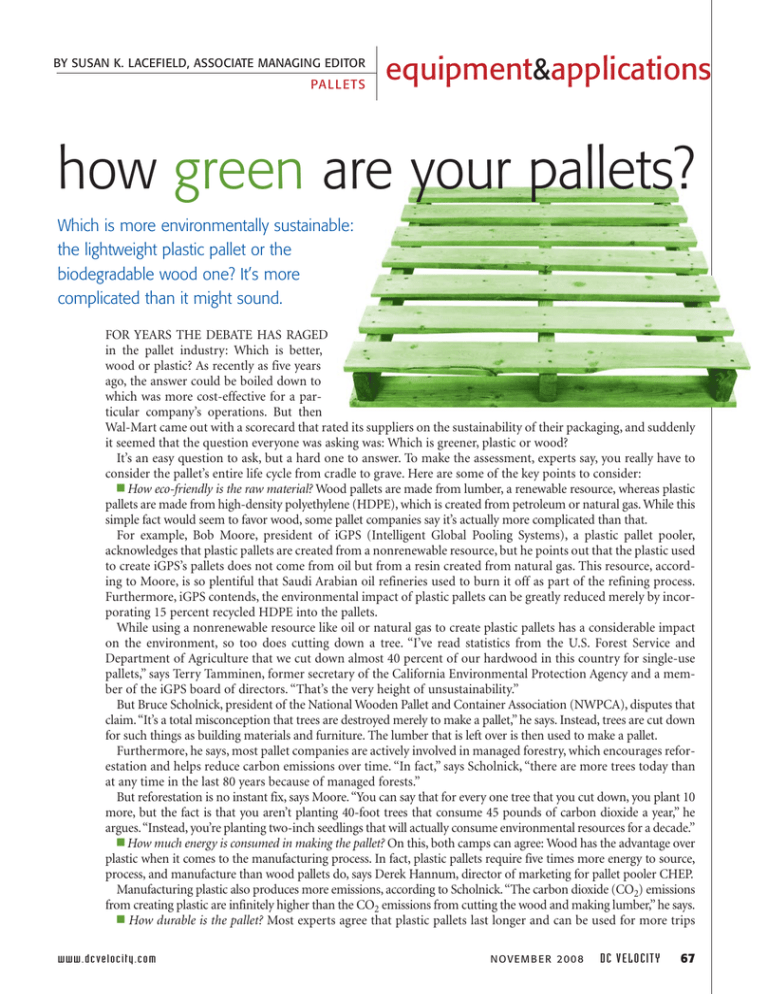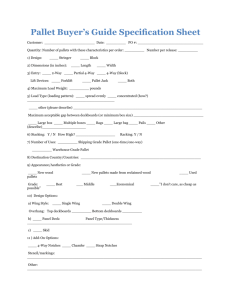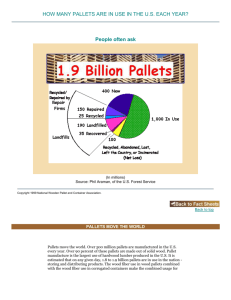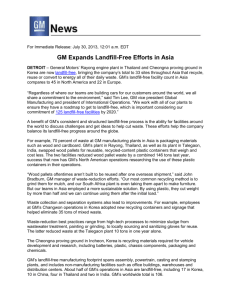how are your pallets? green equipment
advertisement

BY SUSAN K. LACEFIELD, ASSOCIATE MANAGING EDITOR PA L L ET S equipment&applications how green are your pallets? Which is more environmentally sustainable: the lightweight plastic pallet or the biodegradable wood one? It’s more complicated than it might sound. FOR YEARS THE DEBATE HAS RAGED in the pallet industry: Which is better, wood or plastic? As recently as five years ago, the answer could be boiled down to which was more cost-effective for a particular company’s operations. But then Wal-Mart came out with a scorecard that rated its suppliers on the sustainability of their packaging, and suddenly it seemed that the question everyone was asking was: Which is greener, plastic or wood? It’s an easy question to ask, but a hard one to answer. To make the assessment, experts say, you really have to consider the pallet’s entire life cycle from cradle to grave. Here are some of the key points to consider: ! How eco-friendly is the raw material? Wood pallets are made from lumber, a renewable resource, whereas plastic pallets are made from high-density polyethylene (HDPE), which is created from petroleum or natural gas. While this simple fact would seem to favor wood, some pallet companies say it’s actually more complicated than that. For example, Bob Moore, president of iGPS (Intelligent Global Pooling Systems), a plastic pallet pooler, acknowledges that plastic pallets are created from a nonrenewable resource, but he points out that the plastic used to create iGPS’s pallets does not come from oil but from a resin created from natural gas. This resource, according to Moore, is so plentiful that Saudi Arabian oil refineries used to burn it off as part of the refining process. Furthermore, iGPS contends, the environmental impact of plastic pallets can be greatly reduced merely by incorporating 15 percent recycled HDPE into the pallets. While using a nonrenewable resource like oil or natural gas to create plastic pallets has a considerable impact on the environment, so too does cutting down a tree. “I’ve read statistics from the U.S. Forest Service and Department of Agriculture that we cut down almost 40 percent of our hardwood in this country for single-use pallets,” says Terry Tamminen, former secretary of the California Environmental Protection Agency and a member of the iGPS board of directors. “That’s the very height of unsustainability.” But Bruce Scholnick, president of the National Wooden Pallet and Container Association (NWPCA), disputes that claim. “It’s a total misconception that trees are destroyed merely to make a pallet,” he says. Instead, trees are cut down for such things as building materials and furniture. The lumber that is left over is then used to make a pallet. Furthermore, he says, most pallet companies are actively involved in managed forestry, which encourages reforestation and helps reduce carbon emissions over time. “In fact,” says Scholnick, “there are more trees today than at any time in the last 80 years because of managed forests.” But reforestation is no instant fix, says Moore. “You can say that for every one tree that you cut down, you plant 10 more, but the fact is that you aren’t planting 40-foot trees that consume 45 pounds of carbon dioxide a year,” he argues.“Instead, you’re planting two-inch seedlings that will actually consume environmental resources for a decade.” ! How much energy is consumed in making the pallet? On this, both camps can agree: Wood has the advantage over plastic when it comes to the manufacturing process. In fact, plastic pallets require five times more energy to source, process, and manufacture than wood pallets do, says Derek Hannum, director of marketing for pallet pooler CHEP. Manufacturing plastic also produces more emissions, according to Scholnick. “The carbon dioxide (CO2) emissions from creating plastic are infinitely higher than the CO2 emissions from cutting the wood and making lumber,” he says. ! How durable is the pallet? Most experts agree that plastic pallets last longer and can be used for more trips www.dcvelocity.com N OV E M B E R 20 0 8 DC VELOCITY 67 PALLETS equipment&applications than wood ones, reducing the amount of raw materials consumed. For example, iGPS estimates that one of its plastic pallets will make 100 trips in its lifetime. By contrast, the company says, a wooden pallet used in a pool lasts for only 20 trips, and a single-use pallet might be used for as few as two trips. Both CHEP and the NWPCA, however, say that the iGPS numbers grossly underestimate the number of trips a wood pallet can make in its lifetime. ! How much does it weigh? Plastic pallets weigh only about half as much as wood pallets do, which has important implications for transportation. For companies that use 48by 40-inch Grocery Manufacturers Association (GMA) standard pallets, says Moore, using plastic pallets can shave anywhere from 500 to 2,000 pounds off a trailerload’s weight. “Less weight means less diesel fuel,” he adds, “which means a smaller carbon footprint.” ! Can the pallet be repaired? Plastic may last longer on average than wood, but wood pallets are easier to repair. “You just pull a board out and nail another one in,” says Scholnick. That allows you to extend the life of the pallet for quite a number of years, adds Hannum. It used to be that plastic pallets weren’t repairable and had to be recycled if damaged. But that’s beginning to change. Plastic pallet makers have recently introduced models that are designed to be repairable, and CHEP is looking into introduc- 68 DC VELOCITY N OV E M B E R 20 0 8 ing repairable plastic pallets into its pool in the United States. Although repairing a wooden pallet does extend its life, Michal Pelzig of the consulting firm Environmental Resource Management (ERM) says you still have to factor in the fuel consumed and emissions created by transporting damaged pallets to repair locations. CHEP, however, says it has gotten around that problem by locating 80 repair service centers across the nation. This allows the company to repair the pallets close to where its customers use them, says Hannum. ! Can the pallet be recycled? Wood is 100 percent recyclable, says Hannum. When a pallet can no longer be repaired, a recycler can grind it up to be used for alternative products, like mulch and animal bedding. CHEP’s service centers are even experimenting with using wood waste to create fuel. Plastic pallets are also recyclable. When an iGPS pallet is damaged, for example, it is ground down, and the resulting plastic is reused to make a new pallet (although Moore says that the damage rate is so low—0.003 percent—that the company doesn’t have many damaged pallets to draw from yet). Scholnick, however, notes that there’s an environmental cost to recycling plastic pallets. Even if you assume that plastic can be ground up or melted down and reused, he says, you have to account for the energy required to remanufacture that plastic pallet. ! Are there eco-friendly options for disposal? Even the pro- www.dcvelocity.com PALLETS equipment&applications ponents of plastic pallets concede that disposal can be tricky. Unlike wood, which is biodegradable, plastic has a long half-life and when it does start to decompose, it emits methane gas. For plastic pallets to be sustainable, says Moore, the user has to have reverse logistics processes in place to ensure that the pallets don’t end up being thrown out. Operations that don’t have those sorts of controls would be better served by using wood pallets, he admits. Although wood pallets may not pose the same landfill hazards their plastic counterparts do, wood pallet waste is still considered a significant problem. For example, one study found that 6.16 million tons of wood pallets (or 223.6 million pallets) entered municipal solid waste and construction and demolition landfill facilities in 1995. Scholnick, however, argues that those figures are dated and do not reflect current practice. Today, most pallets are picked up by a pallet recycler rather than being dumped in a landfill, he says. And even if the pallet does end up in a landfill, chances are good that it will ultimately be recycled. “It’s too valuable,” Scholnick says. “Even nails are remelted.” Landfill disposal, however, may not be an option in the future. A number of states and municipalities are cracking down on the practice. For example, starting in October 2009, North Carolina will prohibit the disposal of wooden pallets in its municipal solid waste landfills. 70 DC VELOCITY N OV E M B E R 20 0 8 Running the numbers Given all these complex considerations, how can you make an accurate, nonbiased assessment of which material is more sustainable? Is it even possible to weigh the impact of using nonrenewable material to make plastic pallets against the extra fuel burned to transport the heavier wooden pallets? It used to be that any such judgments were made solely on a qualitative basis, says Pelzig of ERM. But for the past five years, researchers have been honing a tool called a lifecycle assessment (LCA), which tries to quantitatively assess the environmental impact of a product over its lifetime. Standardized under ISO 1440 guidelines, LCAs consider factors such as how much solid, liquid, and gaseous waste is generated at each stage of a product’s life. A number of pallet makers have already commissioned assessments of their products. iGPS, for example, hired ERM to conduct life-cycle assessments of the iGPS plastic pooled pallets as well as wooden pooled pallets and single-use wood pallets. The study results, which were published in August 2008 and can be viewed on the iGPS Web site (www.igps.net), found that the iGPS plastic pallet had a lower environmental impact than its wood counterparts in all categories assessed. CHEP, too, has commissioned one of these studies, according to Hannum. Its study, conducted by environmental consulting firm Franklin Associates, compared the pallets used in CHEP’s www.dcvelocity.com equipment pallet pool system to one-way pallets, pallets used in pallet exchanges, and slipsheets. Using data from the study, CHEP created the CHEP Calculator tool, now posted on its sustainability Web site (www.chep.com/onepallet), which calculates how much a company will save in solid waste, energy con- sumption, and greenhouse gas emissions by switching to CHEP pallets. The study, however, did not look at plastic pallets. Although CHEP does use plastic pallets in its U.S. operations, it uses them only in a closed-loop environment. The company elected not to include plastic units in its study because it felt that performance data gathered from pallets used in closed-loop applications might not be valid for pallets used in an open pool. Although pallet makers have made marketing hay with their LCAs, Scholnick of the NWPCA remains skeptical of all the assessments that he has seen, saying that they are all based on flawed data. In particular, he argues that the deciding factor in most of the studies—the number of trips a pallet can make in its lifetime—is based on assumptions. “And that’s totally unfair,” says Scholnick. He says that the “number of trips” standard fails to take into account the resiliency of wood pallets. If a plastic or metal pallet is run over by a truck its first time out, for example, it will likely have to be written off as a total loss, he says, but wood pallets can be continuously repaired and reused. Tamminen, too, urges companies to view these assessments with caution. He recommends having all LCAs evaluated by your environmental health and safety personnel to make sure the data comes from reputable sources and that the analysis doesn’t exclude any stages of the life cycle or define the life cycle too narrowly. Green vs. gold For all the controversy it’s stirring up, it’s unclear how much effect the great wood vs. plastic debate will ultimately have on the industry. In fact, some observers say that end users aren’t even all that concerned about their pallets’ sustainability. Scholnick, for example, maintains that while WalMart may be emphasizing eco-friendly packaging, for most other companies, it’s a secondary, or even tertiary, concern. “Other customers with whom I speak, they’re not talking about sustainability,” he says. “They’re looking for the most cost-effective option that they are certain will get their product safely from point A to point B. That’s what they’re looking for.” Others say customers are genuinely interested in being green, but only if the economics are there. “Customers need a sustainable but also an economically viable option,” says Hannum. “And so, the economics of it are still the primary consideration. Does it offer performance for ! the cost that I need?” 72 DC VELOCITY N OV E M B E R 20 0 8 www.dcvelocity.com






